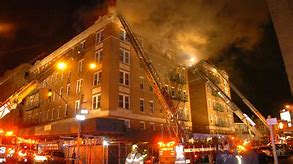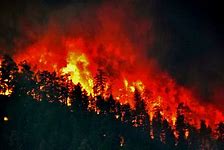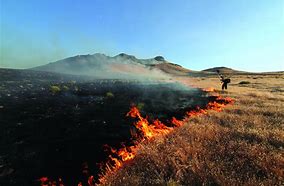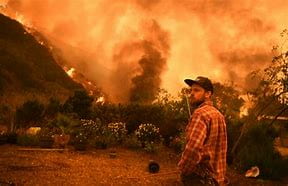As the impact of urbanization, social inequality, climate change, and human migration continues to grow, greater worldwide coordination and action addressing fire safety is urgently needed. The International Fire Safety Consortium (IFSC) engages in research, education, and collaboration with industry, government, and non-governmental organizations to help inform policy and practice, protect property, and save lives.
Addressing Today’s Most Urgent Global Fire Safety Needs
Fires result in hundreds of thousands of deaths each year with financial losses estimated between 1-2% of global Gross Domestic Product (GDP), a total of nearly $3 trillion USD worldwide ([i]). Due to pivotal trends in global urbanization, social inequality, climate change, and human migration, the need to address fire safety as a humanitarian issue has become urgent.
Currently, half of the world’s population lives in cities, and by 2050, two-thirds of people around the globe are expected to live in urban areas ([ii]). Recent statistics indicate that the world’s population will continue to grow beyond 2100, and these population increases are coupled to continued urbanization ([iii]). Global inequality also continues to rise, with the wealthiest 1% of the world having the same total wealth as the poorest 50% ([iv]). Increased urban growth contributes to greater poverty and population density, magnifying the potential devastation of fire in these overcrowded areas.
 Climate change poses a significant challenge to fire safety efforts. Research shows that changes in climate leads to warmer conditions and longer fire seasons, resulting in increased area burned and more frequent fire occurrence ([v]). Combined with substantial growth of wildland–urban interface (WUI) around the world (the area where wildland vegetation and the city’s buildings intermix), fire-related damage to structures and other economic losses in these areas are predicted to increase, especially in the western US ([vi]), where fires in California, such as the 2017 Tubbs fire, continue to cause major damage ([vii]).
Climate change poses a significant challenge to fire safety efforts. Research shows that changes in climate leads to warmer conditions and longer fire seasons, resulting in increased area burned and more frequent fire occurrence ([v]). Combined with substantial growth of wildland–urban interface (WUI) around the world (the area where wildland vegetation and the city’s buildings intermix), fire-related damage to structures and other economic losses in these areas are predicted to increase, especially in the western US ([vi]), where fires in California, such as the 2017 Tubbs fire, continue to cause major damage ([vii]).
In addition to causing hotter and dryer conditions that lead to wildfires, climate change is driving human migration. The Intergovernmental Panel on Climate Change noted that the greatest single impact of climate change may be increased human migration, with millions of people displaced by shoreline erosion, coastal flooding and agricultural disruption ([viii]). According to the Internal Displacement Monitoring Centre, approximately 265 million people worldwide were displaced as a response to natural disasters between 2008-2018 ([ix]). A 2018 World Bank Group report estimates that the impacts of climate change in three of the world’s most densely populated developing regions—sub-Saharan Africa, South Asia, and Latin America—could result in the displacement and internal migration of more than 140 million people before 2050 ([x]).

With significant population migration across the globe due to climate change, as well as conflicts and war, there is an increasing number of people residing in overcrowded areas without adequate living conditions.
Hundreds of millions of people worldwide now live in informal settlements. Informal settlements are over-populated, low-cost residences, typically comprised of shacks. It is estimated that by 2050, there will be 1.2 billion residents living in informal settlements in Africa alone ([xi]). Due to the close proximity of the houses, fires are an ongoing threat in these kinds of settlements. Often there is limited access to water, meaning controlling a fire can be nearly impossible. These problems are exacerbated by the difficulty to regulate such communities.
Fire is an increasing threat not only in informal settlements, but in low- and middle-income communities (LMICs) across the globe, making fire safety a social equality issue. Fire outcomes are generally worse for LMICs, and for those of low socio-economic status, wherever they live. Fire statistics analysis indicates that there are significantly greater fire risks associated with living in social housing and belonging to lower income sectors. These higher risks and poorer outcomes are reflected in greater fatalities, injuries that leave many people with permanent disabilities, and damage to properties, infrastructure and businesses, with impacts not just of immediate economic loss, but also on broader societal development. Urban fires in LMIC’s are an everyday disaster. Recent fire disasters in social housing developments, such as Grenfell Tower in London, demonstrate the higher risk of fire in urban LMICs. The sheer magnitude of the numbers of fires in LMICs, as well as the increased urbanization towards already massive population centres, demonstrate the need for fire safety solutions for these communities.
The large scale of these problems and the increasing societal costs require greater coordinated expertise, public-partnerships, and concerted multidisciplinary research. The International Fire Safety Consortium will fill this need, taking on challenges associated with fire safety in the developing world, social inequality, community resilience, wildfires, climate change and sustainability, and informal settlements.
Focus Areas
The International Fire Safety Consortium is focusing on research, education, and partnerships in the following areas:
Fire Safety in the Developing World
This Consortium seeks to establish a global network on fire safety and resilient affordable housing to address fire safety issues for disadvantaged communities in developing nations around the world. The Consortium will establish a platform for government agencies, research organizations, and the private sector to share and disseminate knowledge, build capacity, and develop innovative solutions to help disadvantaged communities in dealing with the challenges associated with safety, sustainability and resilience.
In partnership with companies, government agencies, and NGOs around the world, the Consortium will facilitate a coordinated approach for improving the housing and living standards of these communities towards a safer, more resilient, low cost and sustainable future based on capacity building, knowledge sharing and establishment of living labs and demonstration projects. These activities will lead to low cost housing techniques and solutions that can provide a more time efficient solution suitable for different parts of the world. The outcomes and knowledge gained from the research activities of our network will be applied globally, specifically in developing countries.

Social Inequality and Fire Safety
To address the issue of social inequality in fire safety, the Consortium seeks to trial pragmatic solutions across a broad range of contexts in different jurisdictions. The Consortium has three main objectives for this focus area:
- to assess, collate and analyse the data available to better understand the relationship between social inequality and fire risks both across and within a representative range of jurisdictions;
- to develop initiatives working with the fire services, local and national government and other relevant agencies within these jurisdictions to increase the quantity and quality of relevant data; and
- to carry out pilot studies, based on comparative analysis of existing and new data, to trial pragmatic approaches for reducing fire risk inequality.
The first step for this project will involve a comprehensive survey of the available data across an appropriate range of jurisdictions. Comparative analysis will provide an initial indication of correlations of key factors with fire outcomes and help identify where improvements in data collection are needed.
The second phase of this project will build on the initial analysis of available statistics and other data sources by developing better means of recording key fire safety information. To address the issue of fire risk inequality, we need data of greater quality covering a wider range of jurisdictions.
The third phase of the project will set out practical measures to address fire risk inequality. Even when countries do have formal building regulations that could reduce fire risks, the application of these is often undermined by failures in governance (either because of a lack of competence or due to corruption) and because many Low and/or Middle Income Countries (LMICs) have high levels of informal settlements. There is scope for improving fire outcomes in LMICs with potential mechanisms, including: the enforcement of building regulations; the construction of suitable infrastructure; the organisation of effective fire services; and public education campaigns.
Community Resilience
The Consortium seeks to develop tools to promote the adaptation of communities to the potential risks of fire as well as the transformation of communities following exposure to fires. Promoting a shared community ownership for fire safety is key to achieving this goal in addition to any engineering solutions that may contribute to reducing the overall risks. Low cost and affordable fire safe housing is vital to long term community adaptation to the risk of fire spread in informal settlements.
Such an objective could be achieved through understanding the mechanism for fire spread through informal settlements, the response of the community to this, and the cultural factors that influence the construction type and the human response. This understanding could be applied to developing technical solutions to slow or inhibit fire growth and spread; to reduce the frequency of fire; and to better inform the populations as to their own role in contributing to fire safety.
Wildfires and Wildland-Urban Interface
Increasing our understanding of wildland fires and their influence on the Wildland-Urban Interface (WUI) is a complex task, particularly due to large variability in scale. Additionally, structures in the WUI may be ignited directly from nearby wildland vegetation and other buildings, but also by firebrands and embers (burning material that can be carried aloft for up to 35 km). Effective management of the WUI will require diverse fields of expertise and multi-agency collaboration.
Combining the efforts of fire scientists, ecologists, engineers, designers, and sociologists collaboratively on the problem could have an enormous impact on reducing their detrimental effects in the future.
This work could be realised through a series of interconnected tasks: understanding dynamic fire behaviour in wildfires and their transition to WUI; investigating emissions and their health impacts both short and long term; assessing risk of wildfires on critical infrastructures and communities; developing new standards and regulations; and evaluating the social aspect of wildfire problem, looking at communities preparedness and their response. These activities are likely to save human lives, reduce damage and economical losses from wildfires and WUI fires. Obtained results will be valuable for both developing and developed countries.
The Consortium will also provide a benchmark for professional standards in the fire safety field, delivering modern and innovative education for a next generation of designers and decision makers. The Consortium will engage in research and education to support and advance a globally recognised fire safety profession.
White Papers
- Wildland/WUI Fires (Point of contact: Alexander Filkov)
- Battery Fire Safety (Point of contact: David Lange)
- Fire Risk in the Global South (Point of contact: David Rush)
- Fire-safe Affordable Housing (Point of contact: Stanislav Stoliarov)
- Sustainable Fire Safety (Point of contact: Margaret McNamee)
- Education Opportunities (Point of contact: Arnaud Trouvé)
Citations:
(i) McNamee, M., Meacham, B., van Hees, P., Bisby, L., Chow, W.K., Coppalle, A., Dobashi, R., Dlugogorski, B., Fahy, R., Fleischmann, C., Floyd, J., Galea, E. R., Gollner, M., Hakkarainen, T., Hamins, A., Hu, L., Johnson, P., Karlsson, B., Merci, B., Ohmiya, Y., Rein, G., Trouvé, A., Wang, Y., Weckman, B., “IAFSS Agenda 2030 for a Fire Safe World,” Fire Safety Journal, 110. DOI: 10.1016/j.firesaf.2019.102889 (2019) https://www.sciencedirect.com/science/article/pii/S0379711219303509
[ii] United Nations, 2018 Revision of World Urbanization Prospects, Population Division, 2018.
[iii] United Nations, World Population Prospects: The 2017 Revision, Key Findings and Advance Tables., in Department of Economic and Social Affairs, Population Division. 2017. p. 53.
[iv] Oxfam, An Economy for the 1%. Oxfam Briefing Paper, 2016. 210: p. 44.
[v] Flannigan, M.D., Stocks, B.J., Turetsky, M.R., Wotton, B.M. 2009. Impacts of climate change on fire activity and fire management in the circumboreal forest. Global Change Biology 15, 549-560.
[vi] Hammer RB, Stewart SI, Radeloff VC (2009) Demographic trends, the wildland–urban interface, and wildfire management. Soc Nat Res 22(8):777–782
[vii] Kramer Heather Anu, Mockrin Miranda H., Alexandre Patricia M., Radeloff Volker C. (2019) High wildfire damage in interface communities in California. International Journal of Wildland Fire, https://doi.org/10.1071/WF18108
[viii] Brown, O. Migration and Climate Change, International Organization for Migration, 2008, p. 9
[ix] Ponserre, S. and Ginnetti, J., Disaster Displacement: A Global Review, 2008-2018, Platform on Disaster Displacement, 2018.
[x] Rigaud, K., et al., Groundswell: Preparing for Internal Climate Migration. World Bank, Washington, DC. 2018. https://openknowledge.worldbank.org/handle/10986/29461
[xi] Walls Richard, S., Appraisal of fire safety interventions and strategies for informal settlements in South Africa. Disaster Prevention and Management: An International Journal, 2019. 28(3): p. 343-358.

